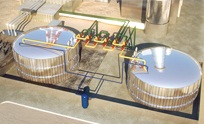BrightSource adds molten salt thermal storage to its solar technology
 BrightSource Energy, Inc. introduced its SolarPLUS thermal storage technology. The technology, which uses molten salts as a thermal storage medium, allows its solar thermal power plants to produce electricity even without the sun.
BrightSource Energy, Inc. introduced its SolarPLUS thermal storage technology. The technology, which uses molten salts as a thermal storage medium, allows its solar thermal power plants to produce electricity even without the sun.
BrightSource’s LPT power tower solar thermal system is the heart of the 392-megawatt Ivanpah Solar Electric Generating System, which is being constructed even now (summer 2011). The tower is surrounded by a field of heliostats on solar trackers that focus sunlight on the tower, superheating water into steam to power a turbine. However, at this point, the plant will not include the SolarPLUS storage technology, according to BrightSource spokesperson Keely Wachs.
“We’ve spent the past two years engineering this storage to couple with our high-efficiency LPT solar thermal technology,” Wachs said. “The storage component [i.e., molten salt] is proven and has been used for decades.”
The majority, 60 percent, of the salts are sodium nitrate. The rest, 40 percent, is potassium nitrate.
“Our current 2.6 gigawatts of contracts with PG&E and SCE do not include storage. However, our launching of SolarPLUS is driven largely by the needs of utilities and their customers,” she said. “Today utilities are placing greater value on those resources that can produce power when utilities need it most—in late peak hours—and that can add reliability value compared to intermittent resources.”
By adding the SolarPLUS technology, such a tower could produce power into the evening, during cloudy periods or in the morning. The technology uses a two-tank thermal storage unit to release and absorb heat, according to a press release.
“The molten salt will be used to store the heat from the steam,” Wachs said. “The higher the steam, the more efficiently a plant can convert the heat stored in the salts back to use for a steam turbine.”
The company is able to reach higher temperatures and pressures than other solar technologies, according to Wachs.
“These higher efficiency levels result in improved economics in solar and storage power production,” she said. “Today, BrightSource’s plants are producing the world’s highest temperature and highest pressure steam from solar. The tower design allows for greater efficiency improvements with the ability to follow the steam turbine operating curve.”
The technology is being made available worldwide, according to Wachs. Depending on the project and local needs, the systems will be designed to meet end-user needs.
“The amount of storage provided in a SolarPLUS plant depends on a utility’s specific needs,” she said. “In theory, it is possible to produce 24/7—as we have seen in Spain with the Gemasolar project—but we believe it’s unlikely that this will have commercial appeal in our principal markets. At present, we see the provision of two to six hours of storage as ideal to fit the needs of utilities in our primary global markets.”
Image courtesy of BrightSource.



